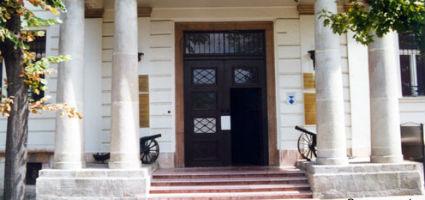2024. November 21. Thursday
HM, Museum and Institution of Military History - Budapest
 |
Address: 1014, Budapest Tóth Árpád sétány 40.
Phone number: (1) 325-1600, (1) 325-1601
E-mail: him@militaria.hu
Opening hours: 01.04-31.09.: Tue-Sun 10-18
01.10-31.03.: Tue-Sun 10-16 |
Museum tickets, service costs:
|
Ticket for adults
|
1400 HUF
|
/ capita
|
|
Ticket for students
(6-26 years of age)
|
700 HUF
|
/ capita
|
|
Group ticket for students
|
300 HUF
|
|
|
Ticket for pensioners
(62-70 years of age)
|
700 HUF
|
/ capita
|
|
Ticket for families
(max. 2 adults + 4 children)
|
2500 HUF
|
/ family
|
|
Program ticket
|
700 HUF
|
|
|
Guide
|
700 HUF
|
|
|
Guide
|
8000 HUF
|
/ max. 20 capita
|
|
Guide
|
12000 HUF
|
/ min. 20 capita
|
The opening exhibition at the Hungarian Institute & Museum of Military History is not an ordinary military showing. It intends to show war from the point of view of soldiers, as they saw the horror of wars from behind wire fences and the depth of trenches.
The visitors can also have insight into the everyday life, concerns and, it may sound strange, joys of soldiers via the photos shown. The visitors can also learn about the work of Volunteer Guards, the safety measures concerning soldiers, the work of red Cross, that at hospitals as well as humanitarian actions. The photos and objects also justify the work of padres.
Curiosities like the role of women in the army, animals faithfully serving soldiers, eg. dogs, pigeons, horses, buffaloes etc are dealt with. The exhibition is to commemorate those who never returned home and those who did survived. It also remembers the civilians of the hinterland wishing for peace working for many, collecting for the soldiers at war, nursing the wounded, trying to stay human in inhuman circumstances, as well as soldiers who spent time with carving bracelets, cups, boxes etc during ceasefire. The objects recall individual desires and emotions. The posters are reminders of the atmosphere of the era. The idyllic scene of a blind soldier and a ballet dancer on a flyer is shocking.
The humongous dimensions of the war are betrayed by countless badges, medallions and tablets. The great number ribbon of wound medallions also betray the number of wounded. Medallions on occasion of the coronation of Charles IV. in 1916, for Christmas and for the Auguszta Bases were also issued. The sports event organized for officer prisoners of war, the deed of dogs in search of wounded are remembered via tablets.
Most of the documents embody the official propaganda and the rigor of politics. Orders, vouchers and posters are about human life being bizarrely militarised. Theatres were still open during wars but wartime plays were staged. Museums were open but the visitors found war related fine art. The topic of exhibition presenting drawings of children is none but war. The pronounced intention of the showing is to remember and make the visitors remember this generation that learned hardship.
The actuality of the permanent exhibition was that we celebrated the 160th anniversary of the Hungarian Army and the 90th anniversary of the establishment of the Hungarian Institute & Museum of Military History.
The visitors can also have insight into the everyday life, concerns and, it may sound strange, joys of soldiers via the photos shown. The visitors can also learn about the work of Volunteer Guards, the safety measures concerning soldiers, the work of red Cross, that at hospitals as well as humanitarian actions. The photos and objects also justify the work of padres.
Curiosities like the role of women in the army, animals faithfully serving soldiers, eg. dogs, pigeons, horses, buffaloes etc are dealt with. The exhibition is to commemorate those who never returned home and those who did survived. It also remembers the civilians of the hinterland wishing for peace working for many, collecting for the soldiers at war, nursing the wounded, trying to stay human in inhuman circumstances, as well as soldiers who spent time with carving bracelets, cups, boxes etc during ceasefire. The objects recall individual desires and emotions. The posters are reminders of the atmosphere of the era. The idyllic scene of a blind soldier and a ballet dancer on a flyer is shocking.
The humongous dimensions of the war are betrayed by countless badges, medallions and tablets. The great number ribbon of wound medallions also betray the number of wounded. Medallions on occasion of the coronation of Charles IV. in 1916, for Christmas and for the Auguszta Bases were also issued. The sports event organized for officer prisoners of war, the deed of dogs in search of wounded are remembered via tablets.
Most of the documents embody the official propaganda and the rigor of politics. Orders, vouchers and posters are about human life being bizarrely militarised. Theatres were still open during wars but wartime plays were staged. Museums were open but the visitors found war related fine art. The topic of exhibition presenting drawings of children is none but war. The pronounced intention of the showing is to remember and make the visitors remember this generation that learned hardship.
The actuality of the permanent exhibition was that we celebrated the 160th anniversary of the Hungarian Army and the 90th anniversary of the establishment of the Hungarian Institute & Museum of Military History.
|
Related activities
|
|||